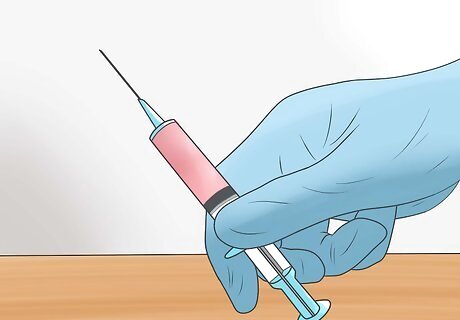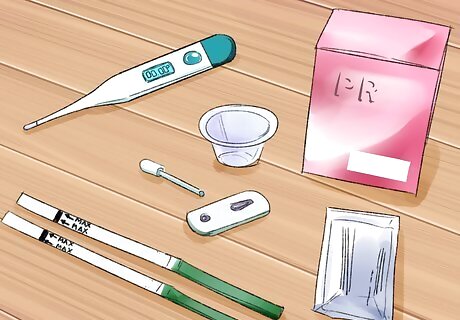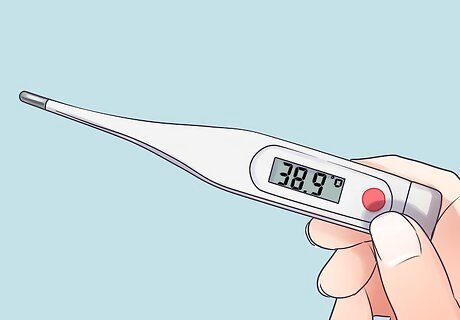
views
Making Adjustments for the Long Distance

Have regular sex. When you are trying to conceive in a long distance relationship, you will need to make sex a focus of your relationship. Regular sex is important for conception. Depending on how frequently you and your partner are together, you may need to have sex during each visit. When you are trying to conceive, it is ideal to have sex every two or three days. This will likely not be possible when you are in a long distance relationship. Monitor your fertility. Try to have sex on the days that your fertility is at its peak. Try to adjust your schedules so that you and your partner see each other as much as possible. When you are together, make sex a priority. For example, if you are together on the weekends, try to have sex once a day. This will increase your odds of conception. Unless there are complications, most women under the age of 35 will become pregnant within the first year of regular unprotected sex.

Enjoy your love life. Obviously, men need to achieve orgasm for their role in conception. Women do not need to orgasm during sex in order to become pregnant. But having a good sex life is important when you are trying to have a baby. If you enjoy sex, you are more likely to want to have sex with your partner. Be open about your sexual needs. For example, try saying, "I really love it when you do ABC." Have a sex life outside of conception. When you are trying to conceive, it can be hard to shift your focus. But remember to have sex because you enjoy being intimate with each other, not just to procreate. Try to plan romantic date nights, not just sex. Spending time laughing and enjoying one another will help you enjoy one another more in the bedroom.

Plan travel in advance. Once you have learned how to chart your fertile window, it becomes easier to plan for sex in a long distance relationship. Try to arrange your time together around times when your body is most receptive to becoming pregnant. Take into account your cycle, your temperature, and your mucus. Choose a time each month to sit down with your partner and make a travel schedule. Figure out who is going to travel and when. When you make your travel plans, consider your work schedules and any social or family engagements. Unexpected things might come up, but you'll be able to get a pretty good idea of what the month will look like. Book plane tickets (or train tickets or rental car reservations) in advance. This will help ensure that you both follow through on your travel plans.

Prioritize your relationship. Try to schedule at least two times each month when you will be together. If something comes up when you are supposed to be traveling to visit your partner, turn down the invitation. Commit to spending quality time with your partner. Keep the lines of communication open. Talk to each other daily and keep in touch via e-mail, Skype, etc. If possible, sort out things like finances, household issues, etc. over the phone or via e-mail. That way, your face to face time can be about enjoying quality time together.

Take special trips. When you are in a long distance relationship, travel can sometimes start to seem like a grind. It can become tiring, and even seem like a burden to feel like you are constantly going back and forth. This is a normal problem to have. Try taking a vacation together. Instead of traveling to see one another, go somewhere entirely different from your homes. Taking a trip together will be a welcome respite from the grind of traveling to the same place all of the time. You will likely relax and enjoy each other. Vacations are a great way to spice up your sex life. Take some time to enjoy the plush hotel room together.

Consider artificial insemination. If you are unable to have regular sex, you can still get pregnant. There are safe and reliable ways to inseminate yourself at home. This method involves some research and preparation, but can help you avoid large medical bills. Collect and ship the sperm. The sperm will need to be placed in an airtight container, and shipped specially. Look for a company that offers cold shipping. You can inseminate yourself at home. A popular product is called the Instead Cup, and can be used to insert the sperm into the woman's body. Track your ovulation using a home monitoring kit available at the pharmacy. When you are ovulating, place the semen in the Instead Cup and insert it into your vagina. You can read more about this process in this helpful wikiHow article. Continue to track your cycle carefully. Artificial insemination works best when you are at your most fertile.

Talk to your doctor. If you have any concerns about your prospects of conceiving, schedule an appointment with your doctor. Have an open conversation with her. Explain that you are trying to conceive while in a long distance relationship and you would appreciate any medical advice. If you are over the age of 35, it is a good idea to speak to your doctor when you begin trying to conceive. Women past that age sometimes face additional challenges. If you have been trying for over a year to conceive with no luck, it is a good idea for both you and your partner to visit the doctor. She can run some tests to help you figure out if there is a medical reason that you have not yet conceived.
Tracking Ovulation to Maximize Your Opportunities

Track your cycle. It is possible to conceive while you are in a long distance relationship. To increase your chances of becoming pregnant, you need to follow several steps to monitor your body to help improve your odds. Learning to track and monitor your menstrual cycle is one of the most important things you can do to monitor your fertility. Tracking your cycle will help you figure out when you are ovulating. Ovulation is when your body releases a mature egg that is ready for fertilization. Ovulation typically occurs around day 14 of your menstrual cycle. Most women have a cycle of about 28 days. You are most fertile in the three days immediately before ovulation. Typically, these are the 11th, 12th, and 13th days of your cycle. Make a note on the calendar on the first day of your period. This is the first day of your cycle. Many women have irregular periods. This can make it more difficult to predict ovulation. You are most fertile in the days leading up to ovulation. This is the ideal time to have sex. If you have to choose only three days a month to be with your partner, choose the three days prior to ovulation.

Monitor your mucus. Paying attention to your body can help you figure out the best times during the month to have sex. You can then plan visits with your partner during those times. Monitoring your cervical mucus is another natural way to help keep track of your most fertile days. Cervical mucus is a thick, fluid like substance released by your vagina. In the days leading up to ovulation, this mucus is more likely to be clear and slippery. It may look like egg whites. On your least fertile days, the mucus will be thicker and cloudier. You may produce no mucus at all after you are done ovulating for the month.

Use an ovulation kit. You can purchase an over the counter product that can help predict ovulation. Most drugstores sell ovulation kits. Ask your pharmacist if he recommends a particular brand. Using an ovulation kit can help you figure out your most fertile days. You and your partner can try to plan to be together on those days. Follow the directions on the package of your kit. You will be testing your urine. You will either collect your urine in a small cup or you will urinate on a stick. Most kits recommend that you try to test your urine at approximately the same time each day for the most reliable results. After waiting the specified amount of time, the test will indicate whether you are in your fertile window or not.

Track your temperature. Another natural way to chart your most fertile days is by keeping track of your body temperature. Basal body temperature is the temperature of your body when it is at rest. This number fluctuates throughout your cycle. Take your temperature each day to help predict ovulation. Your body temperature is lowest during the first days of your cycle. It will increase after ovulation. Typically, your body temperature will be 96-98 degrees before ovulation and 97-99 degrees after ovulation. It is important to take your temperature at the same time and using the same method each day. Keep track of what is normal for your body. Purchase a thermometer that specifically takes basal body temperature. These are available at most drug stores, and you can select an oral or rectal thermometer.
Monitoring Your Physical and Emotional Health

Eat right. In addition to having regular sex, there are other things you can do to make your body more receptive to conception. You can take these steps regardless of how often you and your partner see one another. When you are trying to conceive, it is important to eat a healthy diet. A diet composed of fruits, vegetables, lean proteins, and grains can help ensure that your body functions properly. This includes your reproductive health. 3 months to a year before you plan to start trying to conceive, review your diet to see if you need to make any changes. Ask your doctor to help you if you have questions about proper nutrition. Folic acid is an important nutrient for women. This nutrient is found in leafy greens (spinach), citrus fruits, and whole grains. You should also aim to get plenty of calcium. Try to consume 1000 mg a day by drinking skim milk and eating dairy products such as low-fat cottage cheese. Males should consume plenty of antioxidants, such as those found in berries. This can increase sperm health.

Be physically active. Keeping your body healthy can increase your chances of conception. Make sure that you are exercising regularly to stay in good shape. Work with your doctor to determine your ideal weight. Try to get at least 30 minutes of physical activity in each day. Take a brisk walk or enjoy a yoga or spinning class. Be careful not to overexercise. Women who have regularly exercise vigorously may stop ovulating. This usually only occurs with extreme regimens, such as training for a marathon. Regular exercise can also benefit sperm health. Both partners should aim to be physically active in order to increase the chances of conception.

Increase sperm mobility. There are many things that males can do to increase the odds of conception. Consider ways to make your sperm more healthy. For example, maintaining a healthy body weight helps your sperm be more productive. Avoid smoking and alcohol. Both of these can lower sperm counts, which decrease your odds of conception. Cool off. Try to keep your scrotal area from being too warm. Avoid hot tubs and sitting too long. Loose fitting underwear may help mobility. Avoid using lubricants during sex. Further research is needed, but it is possible that some products can impede fertility.

Take the pressure off. When you are trying to conceive, that can seem like the most important thing in the world. But try to remember that your relationship with your partner is important on many levels. Make sure to continue to have conversations that don't revolve around ovulation. Remember that a relaxed body is more likely to conceive that a stressed out one so focus on relaxation and self care. Conception can be stressful. If one of you needs a break from trying or discussing trying, that's ok. Just be open and honest about your needs. Keep the romance alive. Try to schedule fun activities when you are together. For example, go to a movie or go bowling. Spend time doing things that don't involve sex. Check in with each other. Make sure that you and your partner emotionally support one another on this journey.

Consider alternatives. If you are having trouble conceiving, remember that you have options. Talk to your doctor and your partner about things that you can do. It is entirely possible you just might need more time. If you are having trouble conceiving naturally, your doctor can recommend several types of treatment. She might offer a course of drug therapy, for example. There are other options available to you, such as surgical procedures and Assisted Reproductive Therapy. There are many ways to grow your family, including adoption and foster care.



















Comments
0 comment